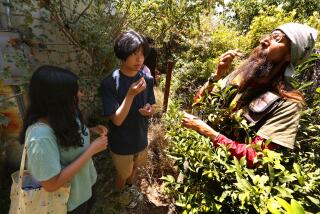Popular Science
- Share via
In the first four months after it opened last year, the California Science Center swelled with half a million visiting students.
That spring, the most popular time for teachers to hold field trips, many visitors complained about the overcrowding.
“All of L.A. was there,” said Lonny Ng, who brought her Anderson Elementary School sixth-grade class from Lawndale in May. “It was a little overwhelming when I saw the 20 buses lined up outside.”
After a year of planning, the center recently launched Think Science, eight private classroom sessions that will ease crowding while providing groups with a more meaningful experience.
The program includes 30- and 60-minute sessions that amplify the museum exhibits. Six sessions delve into earthquakes, the heart, the brain, the transportation system, light and living organisms. Two other programs were expanded to cover the human body’s system for staying in balance and the risks of contracting the AIDS virus.
Similar types of intensive education programs have been popping up nationwide the last several years to help museums forge better bonds with schools.
“I think science museums are coming of age,” said Dave Chittenden, vice president of the Science Museum of Minnesota, which is expanding its school programs.
“We’re having to work a little harder to attract school groups. There’s more competition.”
Think Science, which cost about $500,000 to develop and maintain for one year, brings more discipline and order to the museum’s school program. Before, students would simply pile out of buses and spill into the 245,000-square-foot facility in Exposition Park.
Teachers now make reservations for the programs, receive a series of exercises to prepare the students for the session, are provided with a videotape to introduce the students to the center, and then receive a set of exercises to recap after the field trip.
For this, the students pay $1 to $2.75 per session.
The California Science Center is losing money because of low enrollment, but organizers expect that to change soon.
They have mailed out more than 20,000 brochures to teachers in Southern California, and they are hoping that satisfied teachers, like recent visitor Janis Slinkard, will spread the word.
Slinkard and her 22 seventh-graders from Mission Hills Christian School in southern Orange County visited last month to explore the compartments of a pig’s heart.
Their Think Science instructor, Christina Harris, a USC biology major, found volunteers eager to work with the mango-sized heart.
In one instance, two students shot to the front of the room to cut off portions of a slimy artery and vein.
Harris stretched the vein over one student’s finger and asked him to walk around the group for all to see.
“Please not in their faces,” she said.
“This is so great,” Slinkard said, beaming. “It’s so interactive.”
Although the students had already dissected worms and fish, seen a pig’s heart and looked at informational Web sites in school, they were almost falling off their stools with excitement.
Even teenagers who said they were not usually thrilled by science, such as 13-year-old Kasey Dunn, talked about returning soon, despite the nearly two-hour drive.
“I’m going to bring my dad up here,” he said. “We’re definitely coming back.”
More to Read
Sign up for Essential California
The most important California stories and recommendations in your inbox every morning.
You may occasionally receive promotional content from the Los Angeles Times.













